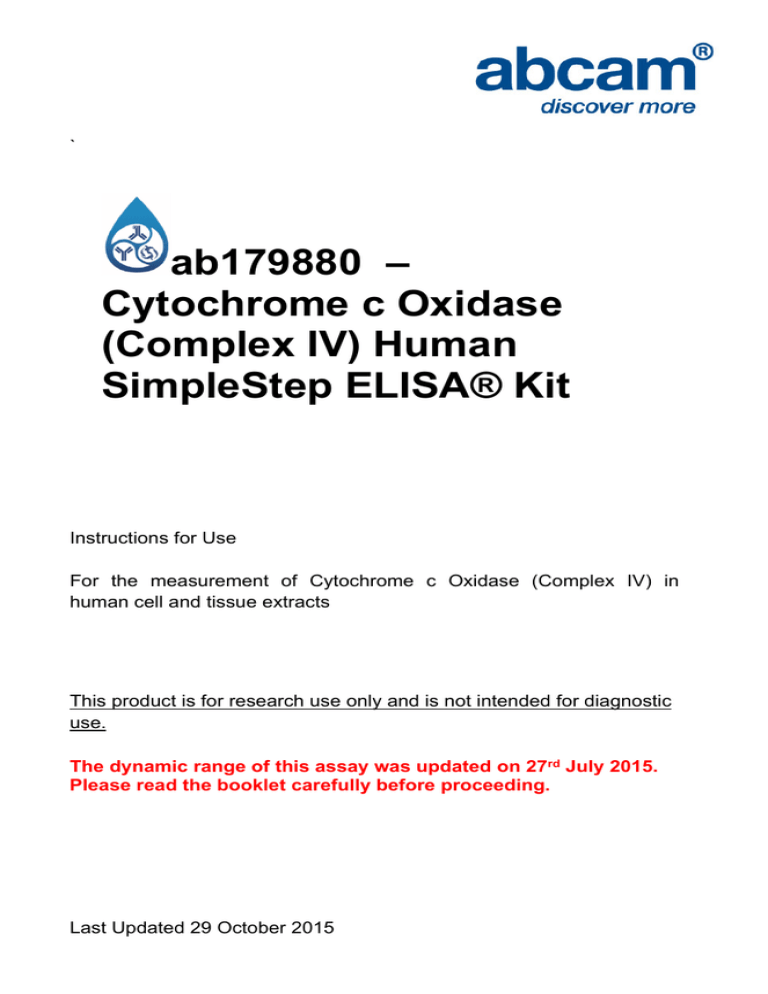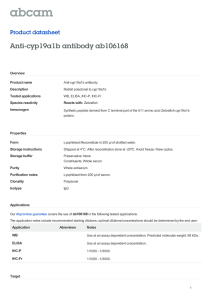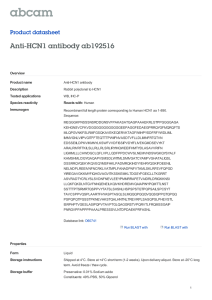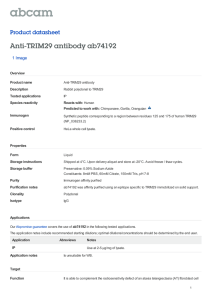ab179880 – Cytochrome c Oxidase (Complex IV) Human SimpleStep ELISA® Kit
advertisement

` ab179880 – Cytochrome c Oxidase (Complex IV) Human SimpleStep ELISA® Kit Instructions for Use For the measurement of Cytochrome c Oxidase (Complex IV) in human cell and tissue extracts This product is for research use only and is not intended for diagnostic use. The dynamic range of this assay was updated on 27rd July 2015. Please read the booklet carefully before proceeding. Last Updated 29 October 2015 Table of Contents INTRODUCTION 1. 2. BACKGROUND ASSAY SUMMARY 2 3 GENERAL INFORMATION 3. 4. 5. 6. 7. 8. PRECAUTIONS STORAGE AND STABILITY MATERIALS SUPPLIED MATERIALS REQUIRED, NOT SUPPLIED LIMITATIONS TECHNICAL HINTS 4 4 4 5 5 5 ASSAY PREPARATION 9. 10. 11. REAGENT PREPARATION SAMPLE PREPARATION PLATE PREPARATION 7 9 11 ASSAY PROCEDURE 12. ASSAY PROCEDURE 12 DATA ANALYSIS 13. 14. 15. 16. CALCULATIONS TYPICAL DATA TYPICAL SAMPLE VALUES SPECIES REACTIVITY 14 15 16 20 RESOURCES 17. 18. TROUBLESHOOTING NOTES Discover more at www.abcam.com 21 22 1 INTRODUCTION 1. BACKGROUND Abcam’s Cytochrome c Oxidase (Complex IV) in vitro human SimpleStep ELISA® (Enzyme-Linked Immunosorbent Assay) kit is designed for the measurement of Cytochrome c Oxidase in cell culture and tissue lysates. The SimpleStep ELISA® employs an affinity tag labeled capture antibody and a reporter conjugated detector antibody which immunocapture the sample analyte in solution. This entire complex (capture antibody/analyte/detector antibody) is in turn immobilized via immunoaffinity of an anti-tag antibody coating the well. To perform the assay, samples or standards are added to the wells, followed by the antibody mix. After incubation, the wells are washed to remove unbound material. TMB substrate is added and during incubation is catalyzed by HRP, generating blue coloration. This reaction is then stopped by addition of Stop Solution completing any color change from blue to yellow. Signal is generated proportionally to the amount of bound analyte and the intensity is measured at 450 nm. Optionally, instead of the endpoint reading, development of TMB can be recorded kinetically at 600 nm. Complex IV, also called cytochrome c oxidoreductase or cytochrome c oxidase, is the terminal proton pump of the mitochondrial electron transport chain where it transfers electrons from reduced cytochrome c to molecular oxygen while pumping protons across the inner mitochondrial membrane. Apart from proton translocation to the intermembrane space, Complex IV also translocates protons to its catalytic site to reduced dioxygen into water. Discover more at www.abcam.com 2 INTRODUCTION 2. ASSAY SUMMARY Remove appropriate number of antibody coated well strips. Equilibrate all reagents to room temperature. Prepare all reagents, samples, and standards as instructed. Add standard or sample to appropriate wells. Add Antibody Cocktail to all wells. Incubate at room temperature. Aspirate and wash each well. Add TMB Substrate to each well and incubate. Add Stop Solution at a defined endpoint. Alternatively, record color development kinetically after TMB substrate addition. Discover more at www.abcam.com 3 GENERAL INFORMATION 3. PRECAUTIONS Please read these instructions carefully prior to beginning the assay. All kit components have been formulated and quality control tested to function successfully as a kit. Modifications to the kit components or procedures may result in loss of performance. 4. STORAGE AND STABILITY Store kit at 2-8ºC immediately upon receipt. Refer to list of materials supplied for storage conditions of individual components. Observe the storage conditions for individual prepared components in sections 9 & 10. 5. MATERIALS SUPPLIED 10X Complex IV Capture Antibody 2 x 300 µL Storage Condition (Before Preparation) +2-8ºC 10X Complex IV Detector Antibody 2 x 300 µL +2-8ºC Antibody Diluent 5BI 2 x 3 mL +2-8ºC 10X Wash Buffer PT 20 mL +2-8ºC 2X Cell Extraction Buffer LM1 10 mL +2-8ºC HeLa Whole Cell Lauryl Maltoside Extract 2 units +2-8ºC TMB Substrate 12 mL +2-8ºC Stop Solution 12 mL +2-8ºC Sample Diluent NS* Pre-Coated 96 Well Microplate (12 x 8 well strips) Plate Seal 12 mL +2-8ºC 96 Wells +2-8ºC 1 +2-8ºC Item Amount *Serum and plasma have not been tested with this ELISA kit but for convenience we provide Sample Diluent NS in this kit. Discover more at www.abcam.com 4 GENERAL INFORMATION 6. MATERIALS REQUIRED, NOT SUPPLIED These materials are not included in the kit, but will be required to successfully utilize this assay: Microplate reader capable of measuring absorbance at 450 or 600 nm. Method for determining protein concentration (BCA assay recommended). Deionized water. PBS (1.4 mM KH2PO4, 8 mM Na2HPO4, 140 mM NaCl, 2.7 mM KCl, pH 7.4). Multi- and single-channel pipettes. Tubes for standard dilution. Plate shaker for all incubation steps. Phenylmethylsulfonyl inhibitors). Fluoride (PMSF) (or other protease 7. LIMITATIONS Assay kit intended for research use only. Not for use in diagnostic procedures. Do not mix or substitute reagents or materials from other kit lots or vendors. Kits are QC tested as a set of components and performance cannot be guaranteed if utilized separately or substituted. 8. TECHNICAL HINTS Samples generating values higher than the highest standard should be further diluted in the appropriate sample dilution buffers. Avoid foaming components. Avoid cross contamination of samples or reagents by changing tips between sample, standard and reagent additions. or bubbles Discover more at www.abcam.com when mixing or reconstituting 5 GENERAL INFORMATION Ensure plates are properly sealed or covered during incubation steps. Complete removal of all solutions and buffers during wash steps is necessary to minimize background. As a guide, typical ranges of sample concentration for commonly used sample types are shown below in Sample Preparation (section 11). All samples should be mixed thoroughly and gently. Avoid multiple freeze/thaw of samples. Incubate ELISA plates on a plate shaker during all incubation steps. When generating positive control samples, it is advisable to change pipette tips after each step. The provided 5X Cell Extraction Buffer contains phosphatase inhibitors. Protease inhibitors can be added if required. The provided 50X Cell Extraction Enhancer Solution may precipitate when stored at + 4ºC. To dissolve, warm briefly at + 37ºC and mix gently. The 50X Cell Extraction Enhancer Solution can be stored at room temperature to avoid precipitation. To avoid high background always add samples or standards to the well before the addition of the antibody cocktail. This kit is sold based on number of tests. A ‘test’ simply refers to a single assay well. The number of wells that contain sample, control or standard will vary by product. Review the protocol completely to confirm this kit meets your requirements. Please contact our Technical Support staff with any questions. Discover more at www.abcam.com 6 ASSAY PREPARATION 9. REAGENT PREPARATION Equilibrate all reagents to room temperature (18-25°C) prior to use. The kit contains enough reagents for 96 wells. The sample volumes below are sufficient for 48 wells (6 x 8-well strips); adjust volumes as needed for the number of strips in your experiment. Prepare only as much reagent as is needed on the day of the experiment. Capture and Detector Antibodies have only been tested for stability in the provided 10X formulations. 9.1 1X Cell Extraction Buffer LM1 Prepare 1X Cell Extraction Buffer LM1 by diluting 2X Cell Extraction Buffer LM1 with deionized water. To make 10 mL 1X Cell Extraction Buffer LM1 combine 5 mL deionized water, 5 mL 2X Cell Extraction Buffer LM1. Mix thoroughly and gently. If required protease inhibitors can be added. 9.2 1X Wash Buffer PT Prepare 1X Wash Buffer PT by diluting 10X Wash Buffer PT with deionized water. To make 50 mL 1X Wash Buffer PT combine 5 mL 10X Wash Buffer PT with 45 mL deionized water. Mix thoroughly and gently. 9.3 Antibody Cocktail Prepare Antibody Cocktail by diluting in the capture and detector antibodies in Antibody Diluent 5BI. To make 3 mL of the Antibody Cocktail combine 300 µL 10X Capture Antibody and 300 µL 10X Detector Antibody with 2.4 mL Antibody Diluent 5BI. Mix thoroughly and gently. Discover more at www.abcam.com 7 ASSAY PREPARATION 10. STANDARD PREPARATION Prepare serially diluted standards immediately prior to use. Always prepare a fresh set of positive controls for every use. The following table describes the preparation of a standard curve for duplicate measurements (recommended). 10.1 Reconstitute the HeLa lyophilized standard sample by adding 1 mL 1X Cell Extraction Buffer LM1 by pipette. Mix thoroughly and gently. Hold at room temperature for 10 minutes and mix gently. This is the 1,000 µg/mL Stock Standard Solution. Remaining stock material should be stored at -80°C. 10.2 Label eight tubes, standards 1– 8. 10.3 Add 300 μL 1X Cell Extraction Buffer LM1 into tube number 1 and 175 μL 1X Cell Extraction Buffer LM1 into numbers 2-8. 10.4 Use the Stock Standard to prepare the following dilution series. Standard #8 contains no protein and is the Blank control: 300 µL 350 µL 350 µL 350 µL 350 µL 350 µL 350 µL µ 1,000 µg/mL 500 µg/mL µ µ µ 333.3 222.2 148.15 98.77 µg/mL µg/mL µg/mL µg/mL Discover more at www.abcam.com µ µ 65.84 µg/mL 0 43.9 µg/mL µg/mL 8 ASSAY PREPARATION 11. SAMPLE PREPARATION TYPICAL SAMPLE DYNAMIC RANGE Sample Type Range (µg/mL) HeLa cell lysate 50 – 400 HepG2 cell lysate 20 - 150 143B cell lysate 70 – 400 Human dermal fibroblast neonatal (HDFn) cell lysate Human liver homogenate (HLH) extract Human heart homogenate (HHH) extract 80 – 400 50 – 300 1–6 11.1 Preparation of extracts from cell pellets 11.1.1 Collect non-adherent cells by centrifugation or scrape to collect adherent cells from the culture flask. Typical centrifugation conditions for cells are 500 x g for 5 minutes at 4ºC. 11.1.2 Rinse cells twice with PBS. 11.1.3 Solubilize pellet at 2x107 cell/mL in chilled 1X Cell Extraction Buffer LM1. 11.1.4 Incubate on ice for 20 minutes. 11.1.5 Centrifuge at 18,000 x g for 20 minutes at 4°C. 11.1.6 Transfer the supernatants into clean tubes and discard the pellets. 11.1.7 Assay samples immediately or aliquot and store at -80°C. The sample protein concentration in the extract may be quantified using a protein assay. 11.1.8 Dilute samples to desired concentration in 1X Cell Extraction Buffer LM1. Discover more at www.abcam.com 9 ASSAY PREPARATION 11.2 Preparation of extracts from adherent cells by direct lysis (alternative protocol) 11.2.1 Remove growth media and rinse adherent cells 2 times in PBS. 11.2.2 Solubilize the cells by addition of chilled 1X Cell Extraction Buffer LM1 directly to the plate (use 750 µL - 1.5 mL 1X Cell Extraction Buffer LM1 per confluent 15 cm diameter plate). 11.2.3 Scrape the cells into a microfuge tube and incubate the lysate on ice for 15 minutes. 11.2.4 Centrifuge at 18,000 x g for 20 minutes at 4°C. 11.2.5 Transfer the supernatants into clean tubes and discard the pellets. 11.2.6 Assay samples immediately or aliquot and store at -80°C. The sample protein concentration in the extract may be quantified using a protein assay. 11.2.7 Dilute samples to desired concentration in 1X Cell Extraction Buffer LM1. 11.3 Preparation of extracts from tissue homogenates 11.3.1 Tissue lysates are typically prepared by homogenization of tissue that is first minced and thoroughly rinsed in PBS to remove blood (dounce homogenizer recommended). 11.3.2 Homogenize 100 to 200 mg of wet tissue in 500 µL - 1 mL of chilled 1X Cell Extraction Buffer LM1. For lower amounts of tissue adjust volumes accordingly. 11.3.3 Incubate on ice for 20 minutes. 11.3.4 Centrifuge at 18,000 x g for 20 minutes at 4°C. 11.3.5 Transfer the supernatants into clean tubes and discard the pellets. Discover more at www.abcam.com 10 ASSAY PREPARATION 11.3.6 Assay samples immediately or aliquot and store at -80°C. The sample protein concentration in the extract may be quantified using a protein assay. 11.3.7 Dilute samples to desired concentration in 1X Cell Extraction Buffer LM1. 12. PLATE PREPARATION The 96 well plate strips included with this kit are supplied ready to use. It is not necessary to rinse the plate prior to adding reagents. Unused plate strips should be immediately returned to the foil pouch containing the desiccant pack, resealed and stored at 4°C. For each assay performed, a minimum of two wells must be used as the zero control. For statistical reasons, we recommend each sample should be assayed with a minimum of two replicates (duplicates). Differences in well absorbance or “edge effects” have not been observed with this assay. Discover more at www.abcam.com 11 ASSAY PROCEDURE 13. ASSAY PROCEDURE Equilibrate all materials and prepared reagents to room temperature prior to use. It is recommended to assay all controls and samples in duplicate. 13.1 Prepare all reagents and samples as directed in the previous sections. 13.2 Remove excess microplate strips from the plate frame, return them to the foil pouch containing the desiccant pack, reseal and return to 4ºC storage. 13.3 Add 50 µL of all sample or standard to appropriate wells. 13.4 Add 50 µL of the Antibody Cocktail to each well. 13.5 Seal the plate and incubate for 1 hour at room temperature on a plate shaker set to 400 rpm. 13.6 Wash each well with 3 x 350 µL 1X Wash Buffer PT. Wash by aspirating or decanting from wells then dispensing 350 µL 1X Wash Buffer PT into each well. Complete removal of liquid at each step is essential for good performance. After the last wash invert the plate and blot it against clean paper towels to remove excess liquid. 13.7 Add 100 µL of TMB Substrate to each well and incubate for 10 minutes in the dark on a plate shaker set to 400 rpm. 13.8 Add 100 µL of Stop Solution to each well. Shake plate on a plate shaker for 1 minute to mix. Record the OD at 450 nm. This is an endpoint reading. Alternative to 13.7 – 13.8: Instead of the endpoint reading at 450 nm, record the development of TMB Substrate kinetically. Immediately after addition of TMB Development Solution begin recording the blue color development with elapsed time in the microplate reader prepared with the following settings: Discover more at www.abcam.com 12 ASSAY PROCEDURE Mode: Kinetic Wavelength: 600 nm Time: up to 15 min Interval: 20 sec - 1 min Shaking: Shake between readings Note that an endpoint reading can also be recorded at the completion of the kinetic read by adding 100 µL Stop Solution to each well and recording the OD at 450 nm. 13.9 Analyze the data as described below. Discover more at www.abcam.com 13 DATA ANALYSIS 14. CALCULATIONS 14.1 Calculate the average absorbance value for the blank control (zero) standards. Subtract the average blank control standard absorbance value from all other absorbance values. 14.2 Create a standard curve by plotting the average blank control subtracted absorbance value for each standard concentration (y-axis) against the target protein concentration (x-axis) of the standard. Use graphing software to draw the best smooth curve through these points to construct the standard curve. Note: Most microplate reader software or graphing software will plot these values and fit a curve to the data. A four parameter curve fit (4PL) is often the best choice; however, other algorithms (e.g. linear, semi-log, log/log, 4 parameter logistic) can also be tested to determine if it provides a better curve fit to the standard values. 14.3 Determine the concentration of the target protein in the sample by interpolating the blank control subtracted absorbance values against the standard curve. Multiply the resulting value by the appropriate sample dilution factor, if used, to obtain the concentration of target protein in the sample. 14.4 Samples generating absorbance values greater than that of the highest standard should be further diluted and reanalyzed. Similarly, samples which measure at an absorbance values less than that of the lowest standard should be retested in a less dilute form. Discover more at www.abcam.com 14 DATA ANALYSIS 15. TYPICAL DATA TYPICAL ASSAY RANGE – Data provided for demonstration purposes only. Standard Curve Measurements Conc. O.D. 450 nm Mean (µg/mL) 1 2 O.D. 0 0.025 0.022 0.023 43.9 0.032 0.034 0.033 65.84 0.033 0.019 0.026 98.77 0.141 0.084 0.113 148.15 0.306 0.298 0.302 222.2 0.933 0.880 0.906 333.3 2.092 2.327 2.210 500 3.910 3.910 3.910 Figure 1. Example of Cytochrome c Oxidase standard curve. The Complex IV standard curve was prepared as described in Section 10. Raw data values are shown in the table. Background-subtracted data values (mean +/- SD) are graphed. Discover more at www.abcam.com 15 DATA ANALYSIS 16. TYPICAL SAMPLE VALUES SENSITIVITY – The calculated minimal detectable (MDD) dose is 64 µg/mL of HeLa lysate prepared according to section 10 of the protocol. The MDD was determined by calculating the mean of zero standard replicates (n=27) and adding 2 standard deviations then extrapolating the corresponding concentrations. RECOVERY – Three concentrations of HeLa lysate were spiked in duplicate to the indicated biological matrix to evaluate signal recovery in the working range of the assay. Sample Type 10% Fetal Bovine Serum Average % Recovery 150 Discover more at www.abcam.com Range (%) 123 - 178 16 DATA ANALYSIS LINEARITY OF DILUTION – Native Cytochrome c Oxidase was measured in the following biological samples in a 1.4-fold dilution series. Sample dilutions are made in 1X Cell extraction buffer LM1. Linearity of dilution is determined based on interpolated values from a calibration curve generated with HeLa lysate prepared according to section 9 of the protocol. Linearity of dilution defines a sample concentration interval in which interpolated target concentrations are directly proportional to sample dilution. Dilution Factor 1.0 1.4 2.0 2.7 3.8 Interpolated value µg/mL % Expected value µg/mL % Expected value µg/mL % Expected value µg/mL % Expected value µg/mL % Expected value HepG2 lysate (100 µg/mL 300.2 100 212.7 99 152.9 100 120.7 110 80.9 104 143B lysate (400 µg/mL) 362.9 100 259.7 100 191.4 103 138.6 105 81.9 87 HDFn lysate (300 µg/mL) 395.7 100 265.9 94 192.4 95 139.4 97 95.7 93 HLH lysate (200 ug/mL) 292.7 100% 201.9 97% 143.6 96% 92.0 86% ND ND HHH lysate (4.5 µg/mL) 383.4 100 261.1 95 193.0 99 146.1 105 108.0 108 PRECISION – Mean coefficient of variations of interpolated values from 3 concentrations of HeLa extracts within the working range of the assay. n= CV (%) IntraAssay 8 2.8 Discover more at www.abcam.com InterAssay 3 7.7 17 DATA ANALYSIS SAMPLE DATA – Figure 2. Titration of HDFN extracts within the working range of the assay. Background subtracted data from duplicate measurements are plotted. Figure 3. Comparison of Cytochrome c Oxidase expression in different cell lines. Background subtracted data from duplicate measurements are plotted. Discover more at www.abcam.com 18 DATA ANALYSIS Figure 4. Measurement of Cytochrome c Oxidase in 143B wildtype (WT) and 143B-derived Rho0 (mitochondrial DNA-depleted) cells loaded at 300µg/mL. The concentrations of Cytochrome c Oxidase were interpolated from a Complex IV standard curve of HeLa cell extract and graphed in percent relative to Cytochrome c Oxidase expression in HeLa cell extract. The concentration of Cytochrome c Oxidase in the Rho0 cell line was not detectable. Discover more at www.abcam.com 19 DATA ANALYSIS . Figure 5. Measurement of Cytochrome c Oxidase in human control and deficient primary fibroblasts. The Levels of Cytochrome c Oxidase deficient fibroblasts with a compound heterozygote mutation in the SURF1 gene >c.311insAT_delTCTGCCAGCC, c.751C>Tp.R251X were measured in comparison to the levels of a control primary fibroblast by loading in triplicate 300 µg/mL of total protein per well. The concentrations of Cytochrome c Oxidase were interpolated from standard curve of HeLa cell extract and graphed in percent relative to Cytochrome c Oxidase expression in the HeLa cell extract. The concentration of Cytochrome c Oxidase in the cell line with the SURF1 mutation was 16% from the control fibroblast. 17. SPECIES REACTIVITY This kit recognizes native human Cytochrome c Oxidase complex in the cell and tissue lysates only. Serum and plasma samples have not been tested with this kit. Please contact our Technical Support team for more information. Discover more at www.abcam.com 20 RESOURCES 18. TROUBLESHOOTING Problem Cause Solution Poor standard curve Inaccurate Pipetting Check pipettes Improper standard dilution Prior to opening, briefly spin the stock standard tube and dissolve the powder thoroughly by gentle mixing Incubation times too brief Ensure sufficient incubation times; increase to 2 or 3 hour standard/sample incubation Inadequate reagent volumes or improper dilution Check pipettes and ensure correct preparation Incubation times with TMB too brief Ensure sufficient incubation time until blue color develops prior addition of Stop solution Plate is insufficiently washed Review manual for proper wash technique. If using a plate washer, check all ports for obstructions. Contaminated wash buffer Prepare fresh wash buffer Improper storage of the ELISA kit Store your reconstituted standards at -80°C, all other assay components 4°C. Keep TMB substrate solution protected from light. Low Signal Large CV Low sensitivity Discover more at www.abcam.com 21 RESOURCES 19. NOTES Discover more at www.abcam.com 22 UK, EU and ROW Email: technical@abcam.com | Tel: +44-(0)1223-696000 Austria Email: wissenschaftlicherdienst@abcam.com | Tel: 019-288-259 France Email: supportscientifique@abcam.com | Tel: 01-46-94-62-96 Germany Email: wissenschaftlicherdienst@abcam.com | Tel: 030-896-779-154 Spain Email: soportecientifico@abcam.com | Tel: 911-146-554 Switzerland Email: technical@abcam.com Tel (Deutsch): 0435-016-424 | Tel (Français): 0615-000-530 US and Latin America Email: us.technical@abcam.com | Tel: 888-77-ABCAM (22226) Canada Email: ca.technical@abcam.com | Tel: 877-749-8807 China and Asia Pacific Email: hk.technical@abcam.com | Tel: 108008523689 (中國聯通) Japan Email: technical@abcam.co.jp | Tel: +81-(0)3-6231-0940 www.abcam.com | www.abcam.cn | www.abcam.co.jp Copyright © 2013 Abcam, All Rights Reserved. The Abcam logo is a registered trademark. All information / detail is correct at time of going to print. RESOURCES 23



![Anti-CD300e antibody [UP-H2] ab188410 Product datasheet Overview Product name](http://s2.studylib.net/store/data/012548866_1-bb17646530f77f7839d58c48de5b1bb7-300x300.png)

